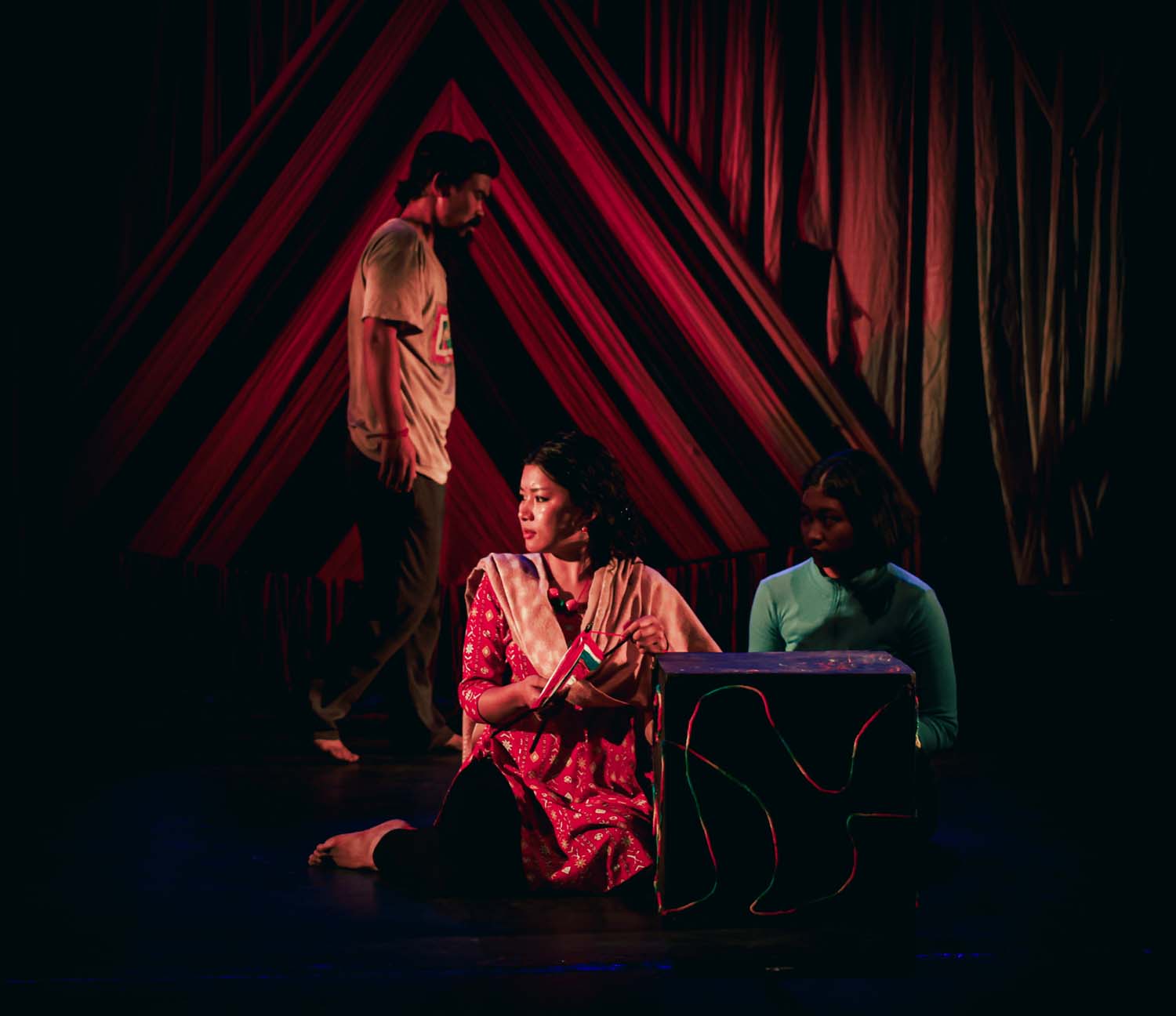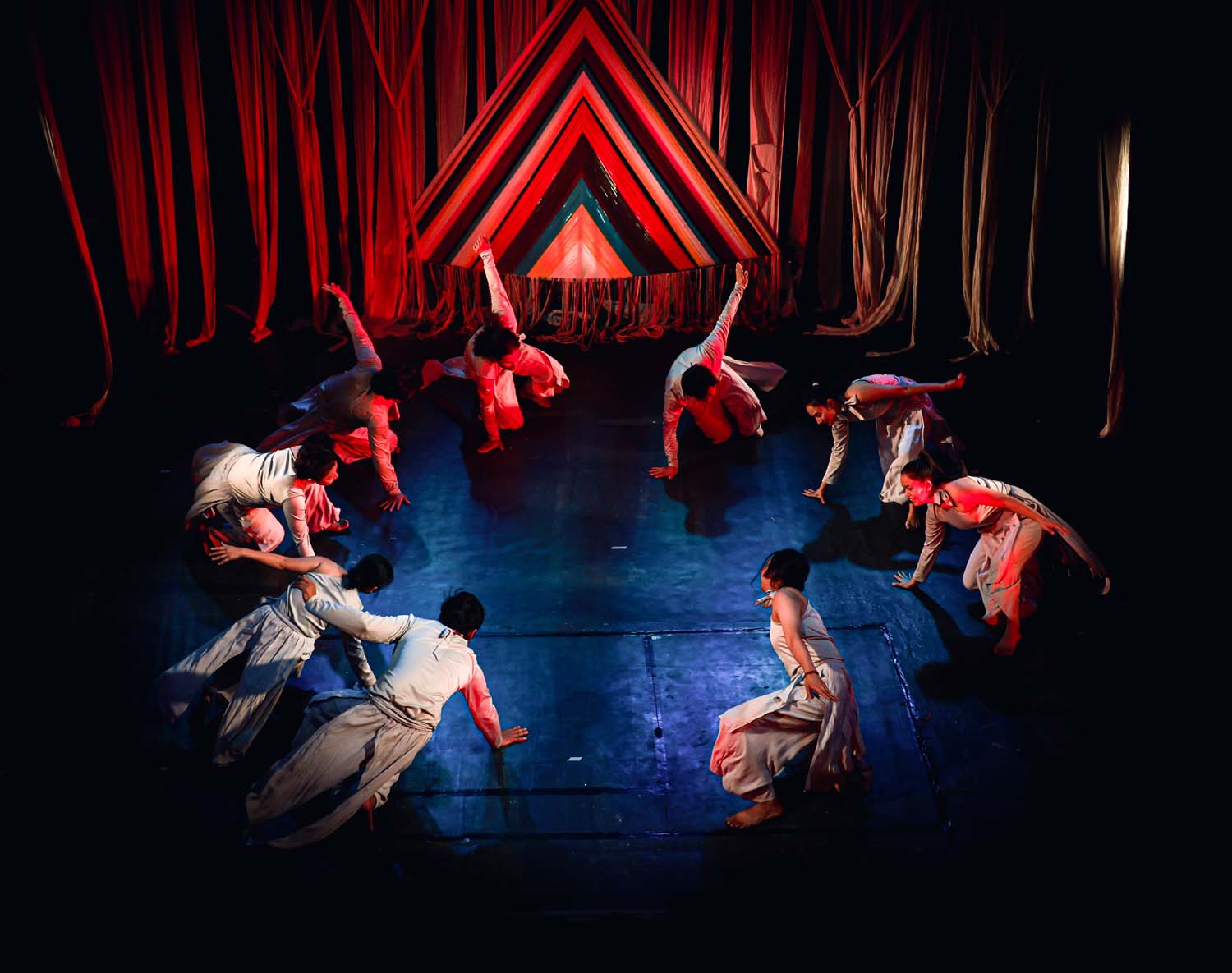Theater
Mental health in the spotlight
Shilpee Theatre’s ‘Awoken Pillow’ examines the topic through a self-aware script, raw acting and beautiful choreography.
Manushree Mahat
Upon entering Shilpee Theatre, you’ll find actors and dancers in between their rehearsals. No opening lines or curtains drawing open to signal the start of the play. A man is seated in the centre while others jump, roam and hit him on the head. His face has melancholy and burden written all over it. He is lost in his thoughts.
This is how ‘Awoken Pillow’ begins at Shilpee Theatre. No warnings are given, leaving the audience to ponder whether the play has started or if an intense rehearsal is underway. ‘Awoken Pillow’ embraces a self-aware narrative, featuring a director who emerges from the audience to critique the artists. This director is a caricature of the contemplative director archetype—an unreliable, wandering and careless artist who delivers grand speeches and mouths demeaning words to the performers. The actor also skillfully replicates the deranged laughter reminiscent of Nawazuddin Siddiqui's character in the Hindi film ‘Kick’.
‘Awoken Pillow’ is an exploration of mental health through the experiences of Sonam (Rupesh Lama), a struggling artist who is on the brink of a collapsing psyche. Despite dedicating his life to theatre, Sonam grapples with frustration over his limited prospects. Nevertheless, he remains committed to honing his craft. Lama’s portrayal of Sonam vividly captures pain, anger and alienation, revealing that his passion has drained him of happiness. As the play progresses, Sonam’s mental state takes a darker turn, with Lama’s acting skillfully portraying the descent into hopelessness. Through two simple yet heart-wrenching words, “I’m sorry,” the audience witnesses the depths of Sonam’s agony.

In the early segments, the play introduces Sonam’s family—Numa (Bedana Rai), his wife and Chhejing (Luniva Maharjan), their daughter. Both suffer amid the tense household atmosphere. Sonam’s wife is frustrated by his lack of income and inability to pay rent, while his daughter feels suffocated and lonely, haunted by inner demons at school. The writing and production merit praise, particularly in scenes depicting Sonam and his wife engaging in heated arguments, with their daughter on the sidelines, isolated and yearning for improvement.
Rai, playing Luma, convincingly portrays a woman burdened with years of family responsibility. The escalating argument between Sonam and Luma unfolds authentically, resembling a glimpse into a genuine dysfunctional household that may make you feel uneasy, as though you’re witnessing something private. Written and directed by JD Tamu, the narrative ensures the family isn’t blamed for Sonam’s deteriorating mental state; they are victims of poverty, and their pain and struggles are valid aspects of their stories.
In ‘Awoken Pillow’, the theatrical experience is heightened through beautiful dance choreography and captivating music, reinforcing the story’s message. When Sonam’s daughter faces rejection and mockery at school, a poignant dance sequence follows, placing her at the core of a tortured, slow contemporary dance. The actor effectively communicates her agony and sense of desolation, reflecting her struggles both at home and in school.
The seamless integration of actors and dancers blurs the lines between the two. Each presence on stage demonstrates a profound understanding of their craft—from the assistant director aspiring for a larger role to the supporting actors playfully executing their tasks, and the choreographer maintaining authority and a clear chain of command. Every character on stage occupies a distinct role, and none seem out of place in their respective positions.

All the cast members of ‘Awoken Pillow’ dedicated months to studying the mental health environment to accurately portray their characters. In scenes set in the mental health hospital and those involving Sonam, the deliberate green lighting, subdued performances, and overall writing vividly depict Sonam and his family grappling with his deteriorating mental health. Despite the melancholic tones, there’s an underlying empathy in these depictions. Sonam is a victim of worsening circumstances, and other patients in the asylum exhibit clear signs of deep-seated trauma, like one patient who constantly mimics finger guns, possibly a result of a traumatic experience in a war zone.
As Sonam’s condition worsens, his family turns to new methods to help him. A spiritual healing session, though filled with striking choreography, fails to significantly improve Sonam’s situation. It’s only when he finds himself surrounded by his family, sharing a yarn with his wife and daughter, that Sonam appears to find peace. The play conveys a significant message about the importance of familial support, lack of prejudice, and love in assisting individuals with mental health issues who face societal ostracism. Tamu's direction emphasises that a loving hug can make a substantial difference.
The final choreography, featuring all performers dressed in white, dancing to a more hopeful routine, leaves the audience with a sense that Sonam and everyone enduring debilitating mental health challenges can find happiness with the support they both desire and deserve.




 13.58°C Kathmandu
13.58°C Kathmandu










